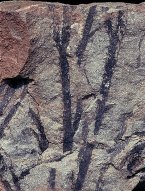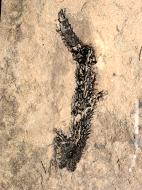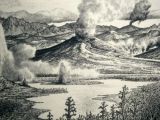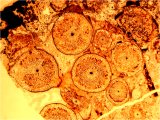A concise report of the development of the flora
I. Silurian and Devonian |
 II.
Carboniferous and Early Permian II.
Carboniferous and Early PermianIII. Permian - Early Cretaceous IV. Cretaceous - present |
| The oldest fossils of land plants visible with the naked eye are
about 425 million years old. They are miniscule plants from the
Mid-Silurian of Ireland en are called
Cooksonia. Cooksonia plants had dichotomously divided
little stems with small knobs at the end. These knobs were sporangia
and they were filled with spores. During about 20 or 30 millions of years
these were the most common plants. They became extinct at the end of the
Early Devonian. In the photo on the left my finest specimen of
Cooksonia. It comes from South Wales and measures 3.5 cm. Click
on the photos for enlargement. Click
here for more information
on Cooksonia. Recently microscopic remains have been found in Oman indicating that land plants existed already 475 million years ago. Probably land plants have developed from green algae living in the sea. |
 |
During the Early Devonian, from about
410 million years ago, more variation came into the flora. New groups of
plants came into existence, but still the plants were small (up to 50 cm).
Flowers developed only 250 millions of years later. Leaves didn't exist either,
except for the scalelike leaves, like those of the clubmosses (click
the photo on the right). Several plants had spines (click photo on the left). These were not for defending the plant, for animal life on the land was still minimal and the land animals were very small (millipedes, collembolans, trigonotarbids ('spiders'), very small crustaceans, etc.). Probably the function of the spines was to enlarge the green surface and so to enhance the assimilation. Furthermore the spines could have given more hold to the plants in forming small bushes of plants of the same species, hanging more or less on each other. |
 |
All plants of that period were cryptogams (plants with spores), like
at present the mosses, the ferns, the clubmosses and the horsetails. But
they are so different from the living plants, that in nearly all cases it
is impossible to identify to which group of recent plants they belong. All
those ancient plants have become extinct.
Relatively little is known about these primitive plants, because only a small
number of complete and well preserved plants have been found. In most cases
the plants have been transported by rivers before they ended up in the mud
and could fossilize. Therefore the plants were mostly cut to small pieces
before getting fossil. There are only a limited number of places where plants
from the Silurian, the Lower and Middle Devonian have been well preserved.
 |
A huge source of information on the oldest land plants is the so
called Rhynie chert. About 400 million years ago there was a kind of Yellowstone Park near the place where Rhynie is now situated (click on the photo on the left). There were erupting vulcanos and geysers belching boiling water, saturated with silicium. That is how a complete silicified marsh came into existence with exceptionally well preserved plants, even showing their cell structure. Many animals have also been found in the chert. The photo on the right shows stems of the plant Rhynia (1 mm in diameter). Click here for a more extensive description of the Rhynie chert. |
 |
|
During the Middle Devonian the plants became taller and little trees
arose, sized up to a couple of meters. Recently a trunk with attached crown
has been discovered in the State of New York. This tree is called
Eospermatopteris and it could be sized up to 8 m. It lived in the
late Middle Devonian. Read
more about this subject. From the Late Devonian, Archaeopteris (don't confuse it with the ancient bird Archaeopterix) is the most well-known tree. It was possibly a predecessor of the conifers and this tree could reach a height of 18 m. The drawing on the left is a reconstruction from the fine website Devonian Times. Especially in Belgium quite a number of plants from the Upper Devonian are found. An example is Rhacophyton, occurring in the region of Liège (click photo on the right), which could very well be a precursor of the ferns. It lacks still leaves, but it has small hooks at the end of the branches. |
 |
At the end of the Devonian the first plants with seeds came into
being. The oldest seed plant of Europe has been found in Belgium and it is
has got its name after the village of Moresnet: Moresnetia (click
photo on the left). This plant has primitive seeds: they are not yet
entirely enveloped, like modern seeds. Recently a precursor of this plant
has been discovered in Belgium with still more primitive 'seeds'. Click
here for a description. The seed plants have become more ande more important in the course of the hundreds of million years. It appeared to be a successful formula because nowadays by far most plants are seed plants. The free-sporing plants have been pushed into the background. Click here for a more extensive description of the early land plants. |